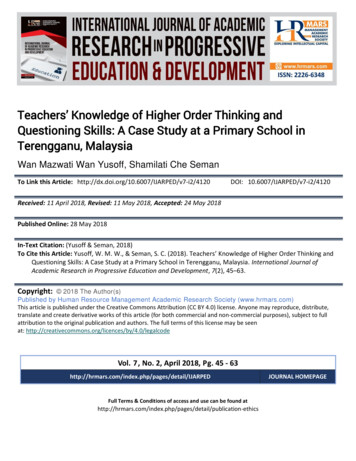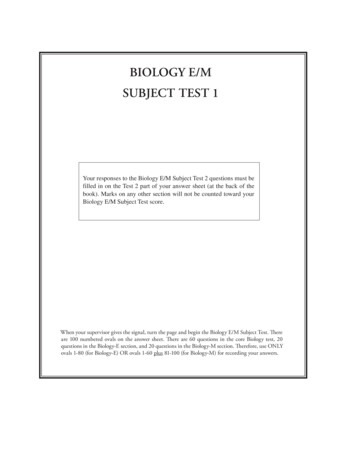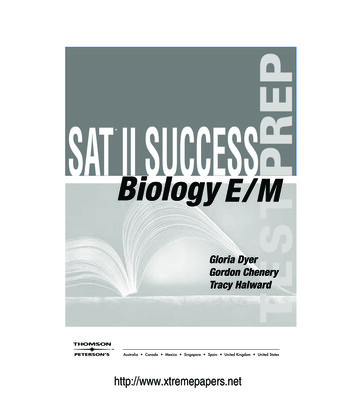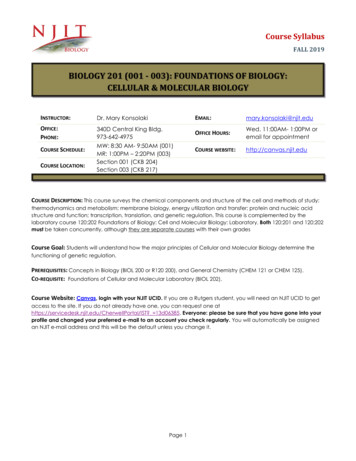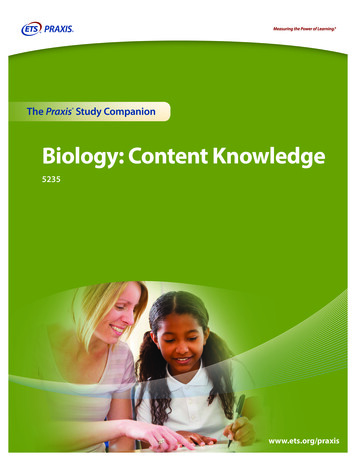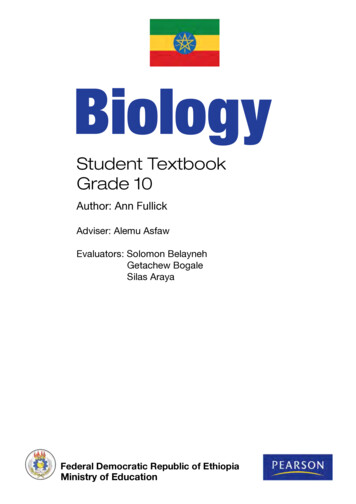
Transcription
BiologyStudent TextbookGrade 10Author: Ann FullickAdviser: Alemu AsfawEvaluators: Solomon BelaynehGetachew BogaleSilas ArayaFederal Democratic Republic of EthiopiaMinistry of Education
BiotechnologyUnit 1ContentsSectionLearning competencies1.1 What is Define biotechnology.biotechnology? Discuss the significance of(page 1) biotechnology. Explain some of the traditional usesof biotechnology, for example, inpreparing bread, yoghurt, cheese andbeer.1.2 New Identify new applications ofapplications ofbiotechnology in agriculture,biotechnologyfood production, medicine and energy(page 7)production.1.1 What is biotechnology?By the end of this section you should be able to: Define biotechnology.KEY WORDS Discuss the significance of biotechnology.biotechnology use ofmicro-organisms to makethings that people want,often involving industrialproductionmicrobiology study ofmicro-organisms and theireffect on humansbacteria unicellular microorganismsviruses sub-microscopicinfectious agents that areunable to grow or reproduceoutside a host cellfungi simple organisms,often microscopic, thatcannot photosynthesiseand feed as parasites orsaprophytesprotoctista unicellularorganisms Explain some of the traditional uses of biotechnology, forexample, in preparing bread, yoghurt, cheese and beer.Biology, as you discovered last year, is the study of living organisms.Now, at the beginning of your grade 10 biology course, you aregoing to be studying biotechnology.Biotechnology is the use of micro-organisms to make things thatpeople want, often involving industrial production.Biotechnology has always been extremely important. It involvesways of making and preserving foods and making alcoholicdrinks. Traditional applications of biotechnology involve brewingbeers, making wines, making bread, and making cheese andyoghurt. Modern applications of biotechnology include usinggenetic engineering to change crops and animals; producing newmedicines; and helping to provide new energy sources. It hasenormous significance in helping people to improve and controltheir lives.Biotechnology is based on microbiology. As you know,microbiology is the study of micro-organisms – tiny livingorganisms including bacteria, viruses, fungi and protoctista,Grade 101
Unit 1: Biotechnologywhich are usually too small to be seen with the naked eye. Somemicro-organisms cause disease; others are enormously usefulto people – for example, they play a vital role in decay and therecycling of nutrients in the environment. With the arrival of newtechnologies such as genetic engineering, micro-organisms arebecoming more useful all the time.KEY WORDSanaerobically withoutoxygenfermentation anaerobicrespiration in yeast thatproduces ethanolNot all types of micro-organism are used in biotechnology. Themain groups are bacteria and fungi, although viruses are beingused more and more for genetic engineering. Just to remind you– bacteria are single-celled organisms that are much smaller thanthe smallest plant and animal cells. In ideal conditions, they canreproduce very quickly. Viruses are even smaller than bacteria.They do not carry out any of the normal functions of living things.Moulds and yeasts are both fungi – living organisms which obtaintheir food from other dead or living organisms. Yeasts are singlecelled organisms, while moulds are made up of thin, thread-likestructures called hyphae.Slime capsule(not always present)GeneticmaterialCellmembraneFlagellum(not alwayspresent)ProteincoatGeneticmaterialCell wallA typical bacteriumA typical virusFigure 1.1 Bacteria (left) and viruses (right) are both used inbiotechnology.NucleusCell wallCytoplasmFigure 1.2 Yeast cells – thesemicroscopic organisms have beenuseful to us for centuries.Developing new applications of biotechnology is one of the fastestgrowing industries around the world, and is beginning to grow inEthiopia too. It is easy to think that biotechnology is very new, butmuch of it has been in use for thousands of years. People have usedmicro-organisms to make food and drink almost as far back as ourrecords go. Bacteria are used in the manufacture of irgo (yoghurt)and Ayib (cheese). Yeast is used to make many traditional Ethiopianfermented foods, including injera, and also to produce alcoholicdrinks, such as tej and tella.Traditional technology using yeastOne of the most useful micro-organisms is yeast. The yeasts aresingle-celled organisms. Each yeast cell has a nucleus, cytoplasmand a membrane surrounded by a cell wall. The main way in whichyeasts reproduce is by asexual budding – splitting into two, to formnew yeast cells. Just one gram of yeast contains about 25 billion cells!When yeasts have plenty of oxygen, they respire aerobically,breaking down sugar to provide energy for the cells, and producingwater and carbon dioxide as waste products. But yeasts are usefulbecause they can also respire anaerobically. When yeast cellsbreak down sugar in the absence of oxygen, they produce ethanol(commonly referred to as alcohol) and carbon dioxide.2Grade 10
UNIT 1: BiotechnologyAerobic respiration provides more energy than anaerobicrespiration, allowing yeast cells to grow and reproduce. However,once they exist in large numbers, yeast cells can survive for a longtime in low-oxygen conditions, and will break down all the availablesugar to produce ethanol. The anaerobic respiration of yeast issometimes referred to as fermentation.We have used yeast for making bread and alcoholic drinks almostas far back as human records go. We know yeast was used to makebread in Egypt in 4000 BC, and some ancient wine found in Irandates back to 5400–5000 BC. Here in Ethiopia yeast (known locallyas ershoo) has been used to make injera (bread) possibly since evenearlier times.Injera needs yeastWhen you make injera, grind your teff or barley and then add water.Mix it well and leave the dough at room temperature for about twodays. Natural yeasts start to grow and respire in the dough. At firstthe yeast respires aerobically, although this may change to anaerobicrespiration. The yeast produces carbon dioxide, making the mix risea little and giving it a tangy flavour. When you cook the mixture,the bubbles of gas expand in the high temperature, giving injera itstypical texture, which is so good for soaking up the food. The yeastsare killed during the cooking process.Activity 1.1: Making injeraYou are going to investigate the factors that affect thegrowth of yeast in injera mix. Yeasts are living organisms – bychanging their conditions, you can change the speed at whichthey respire and produce carbon dioxide in your dough.1. Mix up some teff or barley flour with water, then divide yourmix into three containers.2. Leave one container at room temperature in the normal wayfor making injera.3. Put the second container in the coolest place you haveavailable. If there is a fridge, put your mixture in it.4. Take your third mixture and heat it in a water bath to atleast 50 C. Make sure the mixture itself reaches 50 C for5 minutes. Then allow the mixture to cool down to roomtemperature and leave it with the other sample at roomtemperature.5. After two to three days, observe the three mixtures verycarefully. Describe their appearance and smell.Figure 1.3 When you makeinjera, the mix needs to be leftfor at least two or three days sothe yeast can make the carbondioxide gas needed to produce theholes in the bread.6. Then cook each of the three samples. Observe theirappearance very carefully as they cook – the number ofair bubbles that appear, and the texture of the bread thatresults.7. Write up your experiment carefully, and explain yourobservations.Grade 103
Unit 1: BiotechnologyMaking alcoholic drinksWhen fruits fall to the ground and begin to decay, wild yeasts ontheir skin break down the fruit sugar to form ethanol and carbondioxide. These fermented fruits can cause animals to becomedrunk when they eat them – and this is probably how our ancestorsdiscovered alcohol! We now use this same reaction in a controlledway to make drinks such as beer, tej and wine. In both cases theyeast has to be supplied with carbohydrates to act as an energysource for respiration.Figure 1.4 Here in Ethiopiapeople have been drinking tejfor thousands of years – thefermentation process by whichit is made is an example ofbiotechnology.Tej is one of the oldest drinks known to the human race – it hasbeen known since at least 400 BC. When you make tej, you needhoney, water and gesho leaf or gesho stick. Gesho gives a bitteredge to the brew, and wild yeasts found on the plant start thefermentation going. The yeasts use the honey as a source of food.As the yeast colonies grow they start to respire anaerobically, andthis produces ethanol and carbon dioxide. The alcohol content oftej varies from about 6 to 11%. Tej and tella are the most commonlyconsumed alcoholic drinks in Ethiopia.In contrast, winemaking uses natural sugar, found in fruit such asgrapes, as the energy source for the yeast. You press the fruit andmix the juice with yeast and water. You then let the yeast respireanaerobically until most of the sugar has been used up. At thisstage, you filter the wine to remove the yeast and put it in bottles,where it will remain for some time to mature before it is sold. Mostcommercially sold wine is made from grapes, but wine can be madefrom almost any fruit or vegetable – the yeast doesn’t care where thesugar it uses comes from!Interestingly, alcohol in large amounts is poisonous to yeast as wellas to people. This is why the alcohol content of wine is rarely morethan 14% – once it gets much higher, it kills all the yeast and stopsthe fermentation.Remember: yeast can respire aerobically in bread making, but mustrespire anaerobically to make alcoholic drinks.Activity 1.2: Visiting a brewery/tej productionOne way to become more familiar with the role of yeast inbrewing is to visit a place where beer is brewed, or where tejor other alcoholic drinks are made in your neighbourhood. Youcan discuss with the craftsmen what might affect the growthof the yeast, and how much ethanol they produce duringanaerobic respiration. Discuss what you discover in class withyour teacher and other students.Food production using bacteriaPeople began to domesticate animals quite early in human history.They soon realised that the milk female animals made for their4Grade 10
UNIT 1: Biotechnologybabies could be used as food for us too. People have used milk frommany different types of animal, including cows, sheep, goats, camelsand horses. However, there is one big drawback in using milkas part of the diet – it very rapidly goes off, smelling and tastingdisgusting! It didn’t take people long to discover ways of changingmilk, turning it into milk-based foods with a much longer life thanthe original milk. These changes depend on the action of microorganisms.Yoghurt has long been a staple part of the diet in the Middle Eastand Africa including Ethiopia. Cheese has also been around for avery long time almost all over the world.Making yoghurt (irgo)Traditionally, yoghurt is fermented whole milk. Yoghurt is formedby the action of bacteria on the lactose (milk sugar) in the milk.To make yoghurt, you add a starter culture of the right kind ofbacteria to warm milk. Often this starter culture is just a smallamount of yoghurt you have already made. The mixture needs tobe warm so the bacteria begin to grow, reproduce and ferment. Asthe bacteria break down the lactose in the milk, they produce lacticacid, which gives the yoghurt its sharp, tangy taste. This is known aslactic fermentation. The lactic acid produced by the bacteria causesthe milk to clot and solidify into yoghurt. The action of the bacteriaalso gives the yoghurt a smooth, thick texture. Once the yoghurtforming bacteria have worked on the milk, they also help preventthe growth of other bacteria that normally send the milk bad.Yoghurt, if it is kept cool, will last almost three weeks before it goesbad. Ordinary milk lasts only a few days – and then only if it’s keptreally cold. Once you have made your basic yoghurt, you can mix inflavourings, spices and fruit.Figure 1.5 Many differentanimals, including cows, camels,horses, sheep and goats, are usedfor milking.KEY WORDlactic acid product ofanaerobic respiration inanimal cellsIn Ethiopia, we often make yoghurt (irgo) in gourds or hollowedout wooden vessels that have had sticks burned in them. Thesesticks are obtained from different plants such as the olive tree,and so on. As well as giving the yoghurt a pleasant flavour, thisdisinfects the vessel so that only good bacteria grow in the milk.Activity 1.3: Making yoghurtDiscuss different factors that might affect themaking of yoghurt. Mix up a class starter cultureof milk and a small amount of live yoghurt. Discusswith your teacher what factors might affect howthe bacteria work, and why. Plan your experimentcarefully.1. Working in groups, try different temperatureconditions and see how they affect theformation of yoghurt. You might also changethe pH of the mixture by adding substancesGrade 10such as lemon juice, and see how thisaffects the process.2. After two or three days, make carefulobservations of your yoghurt culture.3. Each group should share their resultswith the class and write them up onthe board.4. Write up your experiments carefully,and explain your observations.5
Unit 1: BiotechnologyCheese makingLike yoghurt making, cheese making depends on the reactionsof bacteria with milk changing the texture and taste, and alsopreserving the milk. Cheese making is very successful in preservingmilk, and some cheeses can survive for years without decay. Around900 different types of cheese are made around the world, but thebasis of the production method is the same for them all.Figure 1.6 Curds are formedby the action of bacteria on themilk – this is the basis of ayib,although we often add seasoningand flavours before we eat it.Did you know?No one really knowswhen yoghurt makingfirst started. It seemsto have come fromTurkey. Legend has itthat travellers took somemilk on a journey in abag made of a sheep’sstomach. The heat of thesun and the bacteria inthe stomach worked onthe milk, and in the coolof the desert night theydiscovered the bag wasfull of yoghurt! Carryingmilk in the stomach ofa camel has a similareffect.Just as in yoghurt making, you add a starter culture of bacteria towarm milk. The difference is in the type of bacteria added. Thebacteria in cheese making also convert lactose to lactic acid, butthey make much more lactic acid. As a result, the solid part (curds)is much more solid than in yoghurt. Enzymes are also added toincrease the separation of the milk. These often come from thestomachs of calves or other young animals. When it has completelycurdled, you can separate the curds from the liquid whey (knownas aguat here in Ethiopia). Then you can use the curds for cheesemaking. The whey is often used in other dishes.The curds can be used fresh, and can be seasoned or flavoured.This is the basis of ayib. Alternatively, you can cut and mix thecurds with salt along with other bacteria or even moulds, beforeyou press them and leave them to dry out. The bacteria and mouldsadded at this stage of the process are very important. They affectthe development of the final flavour and texture of the cheese as itripens – a process that may take months or years, depending on thetype of cheese being made. This is how the majority of cheeses aremade in countries such as the UK and the USA.Here in Ethiopia cheese is traditionally made by first makingyoghurt from fresh milk, extracting the butter by continuousagitation, and finally boiling the remaining part to make the cheese.Review questions1. Which of the following statements about biotechnology is nottrue?A Biotechnology is the use of micro-organisms to make thingsthat people want.B Biotechnology is a new, modern concept.C Biotechnology is based on microbiology.D Biotechnology is one of the fastest-growing industries in theworld.2. How many cells does one gram of yeast contain?A about 10 millionB 25 millionC 4000D about 25 billion6Grade 10
UNIT 1: Biotechnology3. Which two of the following are the waste products of anaerobicrespiration in yeast?A sugarB carbon dioxideC waterD ethanol4. Which of the following statements about lactic fermentation isnot true?A It gives yoghurt its sharp, tangy taste.B It gives yoghurt a smooth, thick texture.C It means the yoghurt will only last a few days.D It causes the milk to clot and solidify into yoghurt.1.2 New applications of biotechnologyBy the end of this section you should be able to: Identify new applications of biotechnology in agriculture,food production, medicine and energy production.Around the world traditional biotechnologies – brewing,winemaking, bread making and the production of yoghurt andcheese – are extremely important. In many countries they are notonly carried out in the home on a small scale, they also take place inmassive industrial production processes.Some new applications of biotechnology also take place in anindustrial setting. Many advances in agriculture are the result ofone of the most important new areas of biotechnology – geneticengineering (also known as genetic modification). Geneticengineering is used to change an organism and give it newcharacteristics which people want to see.What is genetic engineering?Genetic engineering involves changing the genetic material ofan organism. Genetic material carries the instructions for a neworganism, found in the nucleus of every cell. You take a small pieceof information – a gene – from one organism and transfer it to thegenetic material of a completely different organism. So, for example,a gene from one of your human cells can be ‘cut out’ using enzymes,and transferred to the cell of a bacterium. Your gene carries onmaking a human protein, even though it is now in a bacterium.KEY WORDSgenetic engineering/genetic modificationprocess of inserting newgenetic information intoexisting cells in order tomodify a specific organismfor the purpose of changingits characteristicsThere is a limit to the types of protein that bacteria are capable ofmaking. Scientists have found that genes from one organism canbe transferred to the cells of another type of animal or plant at anearly stage of their development. As the animal or plant grows,Grade 107
Unit 1: BiotechnologyHuman cell with Bacterium with ringof DNA called ainsulin gene inplasmidits DNAit develops with the new, desired characteristics from the otherorganism.The technologyPlasmidtaken out ofbacteriumand splitopen by anenzymeInsulin genecut out ofDNA by anenzymeInsulin geneinserted intoplasmid byanother enzymePlasmid withinsulin genein it taken upby bacteriumBacteriummultiplesmany timesThe insulin geneis switched onand the insulinis harvestedFigure 1.7 The basic process ofgenetic engineeringA lot of new biotechnology relies on growing large numbers ofmicro-organisms on an industrial scale in large vessels, known asfermenters. If a lot of micro-organisms are grown together, they caneasily use up all the oxygen available and even poison each otherwith waste products. Industrial fermenters usually have a rangeof features to overcome the problems that stop a culture growingsatisfactorily. They react to changes, keeping the conditions as stableas possible. This, in turn, means we can obtain the maximum yield.Industrial fermenters usually have: an oxygen supply – to provide oxygen for respiration by themicro-organisms a stirrer – to keep the micro-organisms in suspension, maintainan even temperature, and make sure oxygen and food aredistributed evenly through the culture a water-cooled jacket – to remove the excess heat produced bythe respiring micro-organisms – any rise in temperature is usedto heat the water, which is constantly removed and replaced withmore cold water measuring instruments – for continuous monitoring of factorssuch as pH and temperature so that adjustments can be made ifnecessaryProbe to measuretemperature, pH, etc.MotorWarm water outPaddle stirrerFigure 1.8 The design offermenters is improving all thetime as new ways of keepingconditions inside the fermenter asstable as possible are developed allthe time.Water-cooledjacket tomaintainthe correcttemperatureColdwater inOutlet forharvestingthe cultureOxygenThere are many different areas where new biotechnology – and inparticular genetic engineering – is very important. Some of themare summarised on the following pages.8Grade 10
UNIT 1: BiotechnologyApplications of biology in agricultureFor many years, we have used selective breeding to change ourlivestock and crops. We select animals or plants with characteristicswe want, such as big grains, resistance to disease or plenty of milk,and breed from them. Gradually, the characteristics change to whatwe want. But selective breeding takes time, and there are limitationsto it. You will be looking at this in more detail in the next unit.By using genetic engineering, we can introduce new characteristicsvery rapidly. Engineered genes can be used to improve the growthrates of plants and animals. They can be used to improve the foodvalue of crops. Genetic engineering has been used to make cropplants that are resistant to drought and to disease, and to produceplants that make their own pesticide chemicals. Glowing genesfrom jellyfish have even been used to produce crop plants that giveoff a blue light when they are attacked by insects so the farmerknows they need spraying! This means the farmer has to use lessinsecticide (chemicals that kill insects), which saves money andprotects the environment.Much of the research into genetically engineered crops andanimals has been carried out in countries like the UK and theUSA. However, here in Ethiopia our scientists are increasinglyworking with these new technologies. At the Ethiopian Institute ofAgricultural Research and Addis Ababa University, scientists areanalysing the genes of many of our most important crop plants,including teff. The Ethiopian Agricultural Research Institute is usingmodern biotechnology to improve teff, coffee, fruit plants and someof our forest trees for commercial cultivation.KEY WORDmycoprotein fungal proteinHowever, there are some possible problems with the newbiotechnologies, so we must be careful. Insects may becomepesticide-resistant if they eat a constant diet of pesticide-formingplants. Genes from genetically modified plants and animals mightspread into the wildlife of the countryside, which could makedifficulties. Genetically modified crops are often not fertile, whichmeans farmers have to buy new seed each year. But if these problemscan be overcome, biotechnology offers us the hope of better cropsand more food, both for our own people and to sell internationally.Applications of biology in foodThe new biotechnology is often used in food processing. One ofthe biggest changes is that enzymes are produced by geneticallyengineered bacteria, and the enzymes are then used in theproduction of processed foods and drinks. Enzymes are used toclarify beer. They are used to break down starch and convert thesugars into glucose syrup. They are used to make meat more tender,and to break down the food used to make commercial baby food.Biotechnology plays a big part in food production. It has evenbeen used to create a completely new food based on fungi, whichhas been developed in the UK. It is known as mycoprotein, whichGrade 10Figure 1.9 Plant technologistsat EIAR have improved differentcrops like this teff to ensure foodsecurity.9
Unit 1: Biotechnologymeans ‘protein from fungus’. It is produced using the fungusFusarium, which grows and reproduces rapidly on a relativelycheap sugar syrup in large, specialised fermenters. It needs aerobicconditions to grow successfully, and can then double its mass everyfive hours or so. The fungal biomass is harvested and purified.Then it is dried and processed to make mycoprotein, a pale yellowsolid with a faint taste of mushrooms. On its own, it has very littleflavour, but mycoprotein can be given a range of tastes and flavoursto make it similar to a whole range of familiar foods. It is a highprotein, low-fat meat substitute used by vegetarians, people whowant to reduce the fat in their diet, and people who just want to eatcheap protein.When mycoprotein was first developed, people thought a worldfood shortage was on its way. They were looking for new waysto make protein cheaply and efficiently. The food shortage neverhappened, but the fungus-based food continued. It is versatile, highin protein and fibre, and low in fat and calories, and so has found asecure and healthy place on the meal tables of the developed world.Scientists in Ethiopia and elsewhere are trying to develop a localequivalent of mycoprotein, looking at different plants and fungi thathave a relatively high protein content.Applications of biology in medicineBiotechnology is extremely important in modern medicine. It isused to develop vaccines and to create new medicines. The firstmedicine that really relied on microbiology was penicillin. Thisantibiotic is one of the best-known medicines in the world, and hasrevolutionised medicine in the time since it was first manufactured.We are going to look more closely at this story because it showsclearly how changes in biotechnology make life easier.Figure 1.10 The keen eyes ofAlexander Fleming noticed theclear areas on his plates, and herealised he had made a discoveryof enormous potential.In 1928 Alexander Fleming, a young researcher at St Mary’sHospital in the UK, left some plates on which he was culturingbacteria uncovered near an open window. When he rememberedto look at them, he found bacteria were growing on the surface ofhis dishes, as he expected. But Fleming also noticed spots of mouldgrowing, and around these were clear areas of agar. The bacteriawere no longer growing there. Whatever had blown in through thewindow and started growing on his plates was producing a chemicalthat killed the bacteria.Fleming found that the micro-organism which had invaded hisPetri dishes was a common mould called Penicillium notatum.He managed to extract a tiny amount of the chemical that killedthe bacteria, and used it to treat an infected wound. He called hisextract penicillin. But it was very hard to extract, and very unstableonce extracted, so Fleming decided he wouldn’t be able to obtainuseful amounts of penicillin from his mould.Howard Florey and Ernst Chain were working at Oxford Universityin the UK in a desperate search to find a drug to kill the bacteria10Grade 10
UNIT 1: Biotechnologythat infected wounds suffered by soldiers in the Second World War.They used Fleming’s mould and finally managed to extract enoughpenicillin to show what it could do. They wanted to manufacture itin large amounts, but the yield of drug was very poor.Fleming’s original mould, Penicillium notatum, was extremelydifficult to grow in large cultures, yielding only one part penicillinfor every million parts of fermentation broth. Then a mouldgrowing on a melon in a market was found to yield 200 times morepenicillin than the original. What is more, it grew relatively easilyin deep tanks, making large-scale production possible. By 1945,enough penicillin was made each year to treat seven million people.Modern strains of Penicillium mould give even higher yields. Wegrow the mould in a sterilised medium, containing sugar, aminoacids, mineral salts and other nutrients, which is made fromsoaking corn in water. It is grown in huge 10 000 dm3 fermenters,and still saves many thousands of lives every year.When genetically engineered bacteria are cultured on a large scale,they can make huge quantities of protein. We now use them tomake a number of drugs and hormones used as medicines. Thesegenetically engineered bacteria make exactly the protein needed, inexactly the amounts needed, and in a very pure form. For example,people with diabetes need supplies of the hormone insulin. It usedto be extracted from the pancreas of pigs and cattle, but it wasn’tquite the same as human insulin, and the supply was quite variable.Both problems have now been solved by the introduction ofgenetically engineered bacteria that can make human insulin.Biotechnology also makes it possible to develop vaccines moreeasily.A number of sheep and other mammals have been engineered toproduce life-saving human proteins in their milk. These are muchmore complex proteins than those produced by bacteria, and havethe potential to save many lives. For example, genetically modifiedsheep can make special blood-clotting proteins in their milk. Thesecan be used for people with haemophilia, so they are no longer atrisk from receiving contaminated blood.Applications of biology in energy productionEveryone needs fuel of some sort to provide them with energy.It might be direct energy such as heat to cook on, or it might beindirect energy – heat being used to make electricity, for example.However, there is only a limited amount of fossil fuels such as coal,oil and gas for us to use. Even wood and peat are becoming scarce.Around the world, we all need other, renewable forms of fuel. Thegeneration of biogas from human and animal waste is becomingincreasingly important in both the developing and the developedworld. This depends on biotechnology.Grade 10Figure 1.11 Diabetes is adangerous condition if it isnot controlled with insulin.Biotechnology is making purehuman insulin much more easilyavailable.11
Unit 1: BiotechnologyWhat is biogas?Biogas is a flammable mixture of gases, formed when bacteriabreak down plant material, or the waste products of animals, inanaerobic conditions. It is mainly methane, but the composition ofthe mixture varies depending on what is put into the generator andwhich bacteria are present.Table 1.1 The components of biogasComponents Percentage in the mixtureby volumeFigur
Biology, as you discovered last year, is the study of living organisms. Now, at the beginning of your grade 10 biology course, you are going to be studying biotechnology. Biotechnology is the use of micro-organisms to make things that people want, often involving industrial production. Biotechnology has always been extremely important. It involves

